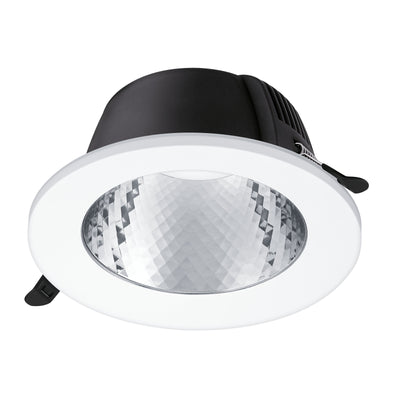Panels
LED panels are efficient and versatile light sources that are increasingly used in professional environments. These flat fixtures provide uniform light distribution and a sleek appearance, contributing to both functionality and aesthetics in offices, retail stores, schools, and hospitals, among others. They effectively replace traditional fluorescent tube fixtures and deliver significant advantages in terms of energy consumption, lifespan, and light quality.
Why choose LED panels?
Switching to LED panels offers tangible benefits for any project. They are a responsible choice considering their long lifespan and minimal energy costs.
- Energy-efficient: An LED panel consumes significantly less energy than conventional lighting. This results in a noticeable reduction in operating costs. Advanced LED technology efficiently converts power into light, offering a direct advantage.
- Long lifespan: With an expected lifespan that can exceed 50,000 burning hours, LED panels require far less frequent maintenance and replacement. This minimizes disruptions and operational costs.
- Uniform light distribution: LED panels distribute light evenly across the space, reducing shadows and creating a comfortable visual environment. This contributes to the productivity and well-being of users.
- Instant brightness: With no warm-up time, LED panels provide full brightness immediately upon being switched on. This is especially relevant in spaces where instant and stable light is required.
- No flickering: LED panels provide stable, flicker-free light, which prevents eye fatigue and improves concentration.

Types of LED panels and their installation
LED panels are versatile due to various mounting options. Each mounting type has specific considerations and is suitable for different ceiling structures and applications.
Recessed LED panels
These panels are the most common choice for suspended ceilings with T-profiles (e.g., 60x60 cm or 120x30 cm). They are easily placed in the opening, allowing them to blend seamlessly into the ceiling.
- Suitable for: Office buildings, schools, shops, public spaces.
- Installation tips: Check the available recess height above the ceiling for the driver. Ensure sufficient ventilation around the panel.
Surface-mounted LED panels
When a suspended ceiling is not available, surface-mounted LED panels offer a solution. These panels are placed in a separate surface-mount frame that is attached directly to the ceiling.
- Suitable for: Concrete ceilings, plastered ceilings, garages, workshops, spaces without a dropped ceiling.
- Installation tips: Mount the surface-mount frame securely to the ceiling. Ensure the wiring is neatly concealed within the frame.
Suspended LED panels
For rooms with high ceilings or when an industrial look is desired, LED panels can be hung using suspension kits. This creates a floating effect and brings the light closer to the work surface.
- Suitable for: Warehouses, showrooms, high-ceilinged office buildings, sheds.
- Installation tips: Use a stable suspension structure. Ensure a level installation to hang the panel straight.

Important specifications for selecting LED panels
The correct functionality of an LED panel depends on various technical specifications. Careful consideration of these parameters ensures that the panel meets the requirements of the specific space and user.
| Specification | Explanation and importance for the installer |
|---|---|
| Lumen (lm) | The total light output of the panel. For functional spaces like offices or workshops, a higher lumen value is usually desired. For ambient or background lighting, a lower value may be sufficient. |
| Kelvin (K) | The color temperature of the light. Warm white (2700K-3000K) creates a cozy atmosphere, while neutral white (4000K) is often used in offices for a bright workspace. Daylight white (5000K-6500K) is suitable for spaces where detail and concentration are essential, such as laboratories. |
| CRI (Ra) | The Color Rendering Index indicates how accurately colors are rendered under the panel's light (maximum 100). For retail stores, art galleries, or healthcare institutions, a high CRI (80+ or even 90+) is important. |
| UGR (Unified Glare Rating) | A value that indicates the degree of glare from the fixture. For spaces with computer screens, such as offices, a low UGR value (UGR < 19) is required to ensure a comfortable working environment and prevent fatigue. For general areas, UGR < 22 is often acceptable. |
| Dimensions | LED panels are available in standard dimensions (e.g., 60x60 cm, 120x30 cm, 120x60 cm) that match modular suspended ceilings. Always measure the recess or module size accurately. |
| Driver type | The driver (power supply) is crucial. Panels can be equipped with an external dimmable (e.g., DALI, 0-10V, Triac) or non-dimmable driver. Pay attention to the compatibility between the panel and driver, and whether a dimming function is desired. |
| IP rating | The Ingress Protection (IP) rating indicates the protection against dust and water. For bathrooms, kitchens, or outdoor applications, higher IP ratings (e.g., IP44, IP65) are necessary. |
You can find more in-depth information about UGR values and their impact on the work environment in our detailed blog post about UGR.

Suitable LED panels for different applications
The choice of an LED panel is strongly influenced by the environment in which it is installed. Each application has specific lighting requirements.
Offices and meeting rooms
A comfortable and productive working environment is important here. Panels with a low UGR value (less than 19) are required to prevent glare on computer screens. Neutral white light (4000K) contributes to concentration.
Retail stores and showrooms
Good color rendering is crucial here to present products attractively. Choose panels with a high CRI (minimum 80, preferably 90+) and a light color that matches the desired atmosphere, ranging from warm white to neutral white.
Schools and educational institutions
Durable and low-maintenance panels are important here. A uniform light distribution with a UGR < 19 and neutral white light (4000K) supports a pleasant learning environment.
Medical spaces and cleanrooms
Specific requirements for hygiene and light quality apply here. IP ratings (e.g., IP44 or IP65) and a high CRI for accurate color rendering are relevant. Some panels even have antibacterial properties.
Industrial environments and warehouses
Robustness and high light output are decisive. Panels with a higher IP rating are recommended in dusty or damp environments. Daylight white (5000K or 6500K) ensures clear visibility at workstations.
Advice for the installer: mounting and connection
Correct and safe installation of LED panels is important for optimal performance and a long lifespan. Here are concrete steps and points of attention for installers.
- Switch off the power: Always start by switching off the power at the fuse box to ensure safety.
-
Choose the mounting method:
- Suspended ceiling: Place the panel and the driver on the T-profiles. Sometimes, extra clamps are needed to secure the panel.
- Surface-mounted: Mount the surface-mount frame level on the ceiling with suitable plugs and screws. Place the panel in the frame and connect the wiring.
- Suspended: Securely attach the suspension cables to the ceiling and the panel. Adjust the length of the cables accurately for a neat result.
- Electrical connection: Connect the driver to the mains according to the supplied instructions. Ensure a correct earth connection. Use suitable terminal blocks or connectors for a safe connection.
- Connect the panel and driver: Connect the panel to the output of the LED driver. The connectors are often specific and prevent incorrect connection.
- Test functionality: Switch the power back on and check if the panel functions correctly. Look for any flickering or irregularities.
For specific product manuals and detailed installation instructions, we advise you to consult the manufacturer's manual or view our comprehensive installation guide .
A responsible choice
LED panels are a strong solution for illuminating professional spaces. They contribute to energy-efficient business operations, require less maintenance, and provide a visually comfortable environment. By carefully considering the various specifications and mounting types, a suitable lighting solution can be realized for any situation. Many installers now opt for LED panels because of their reliability and the positive feedback from end-users.

